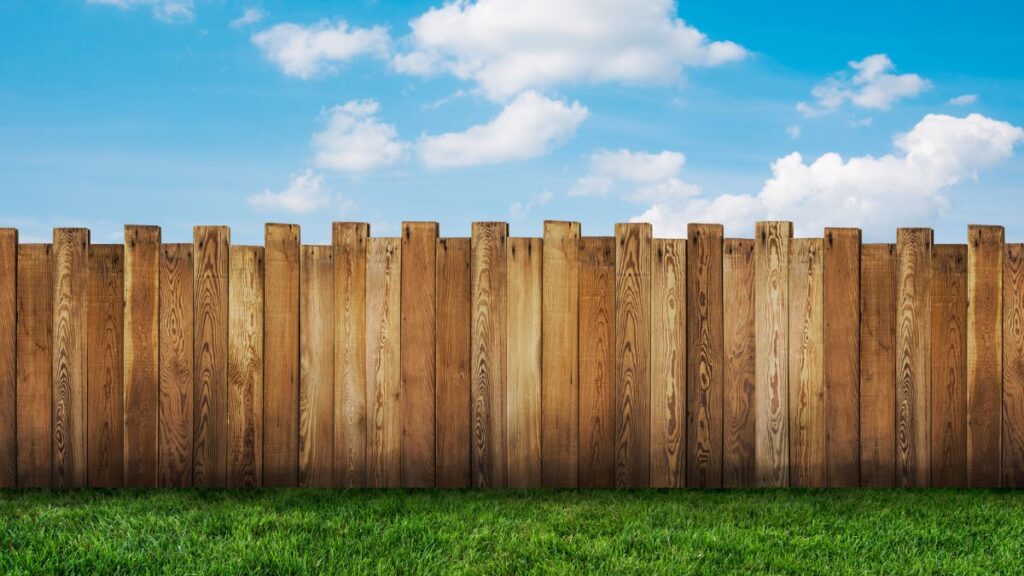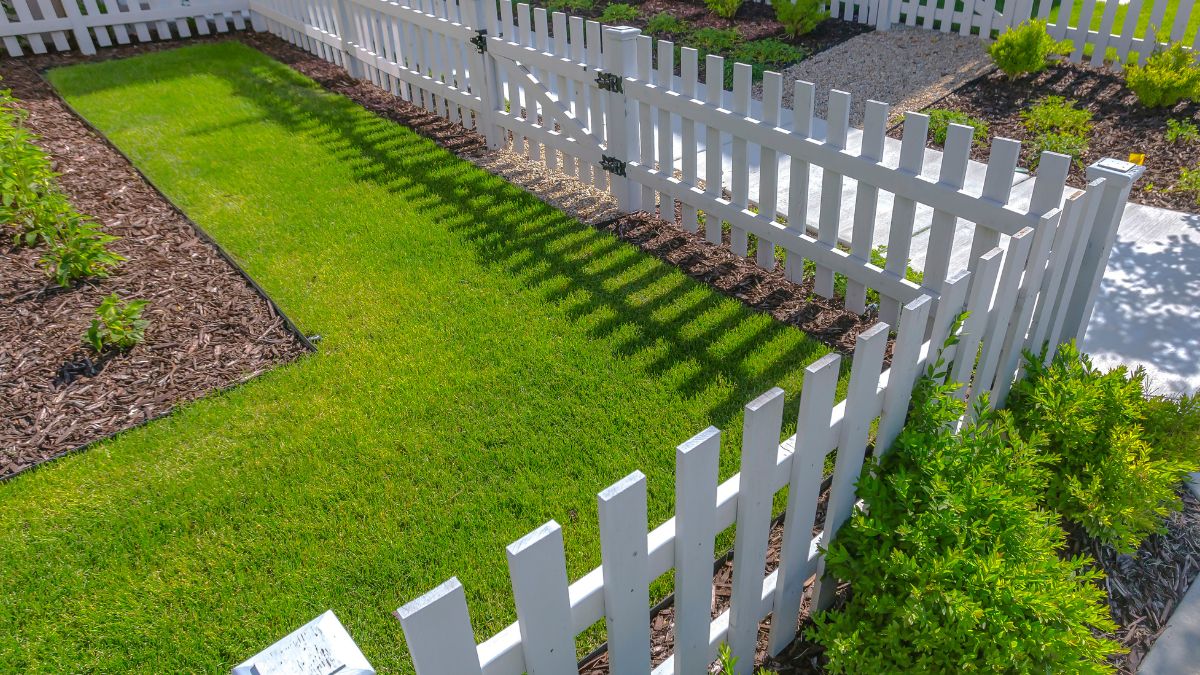Understanding the ins and outs of property boundaries and fences is crucial. It’s not just about knowing who owns what. It’s about understanding your rights and responsibilities as a homeowner. It’s about maintaining good relationships with your neighbors. And most importantly, it’s about ensuring peace of mind.
You see, fences are more than just physical barriers that separate your property from your neighbor’s. They are symbols of your private space, markers of your territory. They can be a source of disputes or a means to maintain harmony. That’s why understanding the legal aspects of fence ownership is so important.
As a homeowner, you share ownership and maintenance responsibilities for any boundary fence with your neighbor. This means you benefit from the fence and should equally contribute to its upkeep. Good communication and understanding local laws are key to avoiding disputes and fostering good neighbor relations.
Who owns the fence between the two houses? You’ll gain insights into the laws regarding fence ownership, the principles of shared responsibilities and costs, and the importance of the Good Neighbor Policy. You’ll also find answers to frequently asked questions about fence ownership.

Unraveling the Legal Aspects of Fence Ownership
Navigating the legal landscape of fence ownership can be a daunting task. But don’t worry; you’re not alone. Let’s break down the general laws, delve into the specifics of California law, and explore other state-specific laws together.
General Laws Regarding Fence Ownership
In property law, fence ownership often hinges on “boundary fences.” These are fences constructed on the property line between two parcels of land.
Both landowners are responsible for maintaining a boundary fence unless one owner decides to construct or repair a fence without the other owner’s input or agreement. In such cases, the owner who builds or repairs the fence may become the sole owner of it.
Here are some key points to remember
- Boundary fences are a shared responsibility.
- The owner who constructs or repairs a fence without mutual agreement may assume full ownership.
- Fence disputes can often be resolved by referring to property deeds and local ordinances.
California Law on Fence Ownership
California has its own unique set of laws regarding fence ownership. Known as the “Good Neighbor Fence Act of 2013,” it presumes that adjoining landowners share an equal benefit from any fence dividing their properties and, therefore, are equally responsible for construction and maintenance costs.
Key aspects of California’s fence laws include
- Adjoining landowners are presumed to share an equal benefit from any boundary fence.
- Both parties are equally responsible for the costs of construction, maintenance, and necessary replacements.
- Any owner planning to incur costs for a boundary fence must give a 30-day notice to the other party, detailing the estimated costs.
Other State-Specific Laws
Laws regarding fence ownership can vary significantly from state to state.
For instance, in Texas, a boundary fence is typically owned by the person who built it unless agreed otherwise.
In contrast, in New York, a fence built for privacy or to mark a boundary is owned by the person who constructed it, but a fence built for containment (like a livestock fence) is considered a mutual boundary fence.
Here are some examples of state-specific laws
- In Texas, the builder of a fence typically retains ownership unless otherwise agreed.
- In New York, ownership depends on the purpose of the fence—privacy fences are individually owned, while containment fences are considered shared.
- In Missouri, two fence laws exist: the general law and a local option counties can adopt.
Remember, local laws and ordinances take precedence when it comes to fence ownership. Always check with your local city or county to understand the specific laws applicable to your area.
Understanding these legal aspects of fence ownership can help you avoid disputes and maintain good relations with your neighbors.

Determining Fence Ownership: A Practical Guide
Determining fence ownership can sometimes feel like solving a complex puzzle. But with the right knowledge and tools, you can confidently piece together the ownership picture.
Let’s explore the role of property deeds and title plans, understand the concept of boundary fences, and examine when the fence rests wholly on one side of the property line.
Role of Property Deeds and Title Plans
Property deeds and title plans play a crucial role in determining fence ownership. They are like the blueprint of your property, outlining its boundaries and any existing structures, including fences.
Here’s how they can help:
- Property Deeds: These legal documents contain a detailed description of your property and its boundaries. They may also include information about any existing fences at the time of purchase.
- Title Plans: These are graphical representations of your property, showing its boundaries. They can help identify where a fence is located about the property line.
By examining your property deed and title plan, you can gain valuable insights into the location of your property boundaries and the ownership of any fences.
The Concept of Boundary Fences
As the name suggests, boundary fences lie on the boundary line between two properties. They are typically shared by the adjoining landowners, who are equally responsible for their maintenance and repair.
Here are some key points about boundary fences:
- Boundary fences are located on the property line between two properties.
- They are typically shared by the adjoining landowners.
- Both landowners are equally responsible for the maintenance and repair of a boundary fence.
When the Fence Rests Wholly on One Side of the Property Line
Sometimes, a fence may rest wholly on one side of the property line. In such situations, the fence is usually owned by the property owner on whose land it stands.
Here’s what you need to know:
- A fence that rests wholly on one side of the property line is typically owned by the owner on whose land it stands.
- The owner of the fence is solely responsible for its maintenance and repair.
- If a fence is built just inside the property line, the builder usually retains ownership.
Determining fence ownership can be complex, but with a clear understanding of property deeds, title plans, and boundary fences, you can confidently navigate this process.
It’s always a good idea to consult with a real estate attorney or a property law expert when in doubt. They can provide you with professional advice tailored to your specific situation.
Shared Responsibilities and Costs: A Balanced Approach to Fence Ownership
When it comes to fence ownership, the principle of shared responsibilities and costs often comes into play. This principle is rooted in the idea of equal benefit and responsibility. But what does this mean for you as a homeowner?
The Principle of Equal Benefit and Responsibility
The principle of equal benefit and responsibility is a cornerstone of fence ownership laws. It’s based on the idea that if two properties share a boundary fence, both owners benefit from it and should share the responsibilities and costs.
Here’s how this principle works
- Both property owners benefit from the privacy, security, and boundary definition that a fence provides.
- Therefore, both owners share the responsibility for maintaining the fence.
- This includes sharing the costs of construction, maintenance, and necessary replacements.
Costs of Construction and Maintenance
The costs of constructing and maintaining a fence can vary widely, depending on factors like the type of fence, the materials used, and the length of the fence. As per the principle of equal benefit and responsibility, these costs are typically shared between the property owners.
Here are some points to consider:
- The cost of constructing a new fence includes materials, labor, and possibly permits.
- Maintenance costs can include painting, staining, repairing damage, or replacing parts of the fence.
- In the case of a shared fence, these costs are usually split equally between the property owners.
When a Fence Needs Repair
So, what happens when a fence needs repair? Who is responsible? As with construction and maintenance costs, the responsibility for repairs typically falls on both property owners.
Here’s what you need to know:
- Both property owners are responsible for the costs of necessary repairs to a shared fence.
- If one owner wants to make improvements that go beyond necessary repairs, they may need to cover the additional costs themselves.
- Communication is key. Discuss any necessary repairs with your neighbor before starting the work.
Understanding fence ownership’s shared responsibilities and costs is crucial. It helps ensure a fair and balanced approach, maintains good neighbor relations, and keeps your fence in top condition.
When it comes to shared fences, communication with your neighbor is key. A clear and open dialogue can prevent disputes and ensure that the fence continues to serve its purpose for both parties.
The Good Neighbor Policy: Fostering Harmony in Fence Ownership
The Good Neighbor Policy is more than just a principle; it’s a way of life that promotes harmony and cooperation between neighbors. When applied to fence ownership and maintenance, it can help prevent disputes and foster a sense of community. Let’s delve into this policy and understand how it applies to your situation.
Understanding the Good Neighbor Policy
The Good Neighbor Policy is all about mutual respect and cooperation. It encourages neighbors to communicate openly, resolve disputes amicably, and share responsibilities fairly. Here’s what it entails:
- Open and respectful communication between neighbors.
- Amicable resolution of disputes, avoiding legal action whenever possible.
- Fair sharing of responsibilities, such as fence maintenance and repair.
The Good Neighbor Policy and Fence Ownership
The Good Neighbor Policy encourages neighbors to share the responsibilities of fence maintenance and repair, fostering a sense of shared ownership.
Here’s how the Good Neighbor Policy applies to fence ownership:
- It encourages neighbors to communicate openly about fence construction, maintenance, and repair.
- It promotes the sharing of costs and responsibilities associated with a boundary fence.
- It fosters a sense of shared ownership, with both neighbors benefiting from the fence and contributing to its upkeep.
In essence, the Good Neighbor Policy is about fostering a sense of community and cooperation. It’s about understanding that a fence isn’t just a boundary; it’s a shared asset that benefits both parties.
By embracing the Good Neighbor Policy, you can ensure your fence serves its purpose without causing disputes or hard feelings. After all, good fences make good neighbors.

Understanding Your Responsibilities Regarding the Fence
Your responsibilities concerning the fence may vary depending on the type of work required.
Aesthetic Maintenance
To maintain its appearance, the fence might need aesthetic upkeep, such as painting. In this scenario, your responsibility typically extends only to the side of the fence facing your property. The appearance of the other side of the fence, which you don’t see and isn’t publicly visible, shouldn’t concern you.
Structural Repairs
But what happens when the fence requires actual repair? Fences made of metal or vinyl can deteriorate or break. Wooden fences, whether board-on-board, picket, stockade, rail, or plank, can sustain damage even more easily than those made of metal, concrete, or other robust materials.
Structural damage can occur due to natural aging or from an impact, such as a fallen tree branch, an intruder, wildlife, or a reckless driver. This type of damage usually affects both sides of the fence.
If the damage is a concern for you but not for your neighbor, you’re faced with a common dilemma: who bears the responsibility for repairing and maintaining a shared fence?
If your neighbor refuses to repair their fence or shows no interest in doing so, your options might be limited. One possible solution is to erect your fence within your property line adjacent to your neighbor’s fence. This would result in two parallel fences, with yours concealing your neighbor’s fence from your view.
Which Side of the Fence Belongs to You?
In numerous regions, as per Findlaw, the law automatically divides the responsibility for a boundary fence among the property owners who benefit from it. Most neighbors comprehend this and willingly accept some responsibility for fence upkeep and repairs.
When fence maintenance or enhancements become necessary, such “good neighbors” are usually ready to do their part and cover their portion of the costs.
Since the fence ownership is shared, neither neighbor can alter, relocate, or remove it without first seeking permission from the other fence owners.
Disagreements over fence responsibilities and costs can potentially sour relationships between neighbors. It’s advisable to discuss your shared fence with your neighbor before an incident like a falling tree branch forces you to confront repair or replacement costs.
If neighbors decline to contribute to shared fence repairs, you may need to contact municipal authorities, file a small claims case, or even engage a lawyer.

Who Erected the Fence?
A property owner who constructs a boundary fence without first securing an agreement from the adjoining neighbor has no right to demand that the neighbor contributes to construction or maintenance costs.
If neighbors mutually agree to erect a boundary fence, that agreement is binding, and both property owners become legally obligated to share the expenses of maintaining that fence.
A question might arise when one neighbor erects a fence that necessitates clearing brush or other obstacles for the fence construction work on another’s property. A fence might also zigzag across a property line to sit partially on one neighbor’s land and partially on the other’s.
A situation could potentially escalate into a trespass or “adverse possession” issue when one neighbor erects a fence entirely on the other neighbor’s property. This could result in unintentionally or intentionally encroaching on your neighbor’s land.
Suppose this encroachment persists for a certain number of years. As per state law, disputed land ownership may legally transfer to the encroaching neighbor, even without compensation. In such a case, it’s crucial to take legal action early to preserve rightful ownership of the disputed land.
Who Gets the Attractive Side of the Fence?
Fences typically have a “good” or appealing side that presents a more finished look and a “bad” or less appealing side that often exposes the fence’s structural components, such as posts and rails.
One trend is the emergence of the “good neighbor fence.” Good neighbor fences alternate the picket and rail sides of the fence on every panel so that each neighbor gets an equal share of the attractive and less attractive sides.
In some areas, fences are required to have the picket side facing any public roads. These rules maintain aesthetics for passing drivers and pedestrians and deter trespassers from climbing over your fence using the rails.
The sides of the fence that face a homeowner have no impact on who owns which side of the fence.
How Can You Determine if Your Fence is Shared?
The initial step in determining whether you own or share your fence involves understanding your property boundaries. Property lines are typically marked by ground pins, iron rods positioned 6 to 10 inches beneath the ground at the outer corners of your property. A licensed surveyor initially placed these pins when the property boundaries were established.
To identify the property lines on your own, you can use a metal detector to locate the pins around your property. Mark the locations where you find the pins with flags and use string to outline your property boundary.
Consider hiring a surveyor if you cannot locate your ground pins or require more precise measurements. They will use GPS coordinates to determine your property boundaries accurately.
Be sure to keep the survey report they provide for future reference. Some communities mandate a land survey before you can construct any fence between houses, whether shared or private, or if you plan to erect another permanent structure like a shed, gazebo, or greenhouse.
While the responsibility for a garden fence can sometimes lead to disputes, the rules and fencing laws are generally clear and cover nearly all potential scenarios.
Beyond knowing who erected the fence or whose property it stands, a verbal or written agreement between the neighboring property legal owners usually determines the ownership of and responsibility for the boundary fence.
FAQs: Who Owns the Fence Between Two Houses
Who owns the fence between two properties?
The fence ownership between two properties often depends on local laws, the terms of property deeds, and the specifics of the fence’s construction. If a fence lies on the boundary line between two properties, it’s considered a “boundary fence,” and both property owners share ownership and maintenance responsibilities.
Who is responsible for maintaining a boundary fence?
Under the principle of equal benefit and responsibility, both property owners are responsible for maintaining a boundary fence. This includes the costs of construction, maintenance, and necessary replacements.
What happens if a fence needs repair?
Both property owners are typically responsible for the costs if a boundary fence needs repair. Communicating with your neighbor about any necessary repairs before starting the work is always a good idea.
What is the Good Neighbor Policy?
The Good Neighbor Policy encourages open communication, amicable dispute resolution, and fair sharing of responsibilities between neighbors. In fence ownership, it promotes shared responsibility and maintenance of boundary fences.
Remember, it’s always a good idea to consult with a real estate attorney or property law expert when in doubt. They can provide you with professional advice tailored to your specific situation.
Wrapping Up
Understanding fence ownership is about more than just knowing who owns what. It’s about fostering good relationships with your neighbors, maintaining your property, and ensuring peace of mind.
Keep these insights in mind, and navigate the world of fence ownership with confidence and clarity. Remember, good fences make good neighbors.







